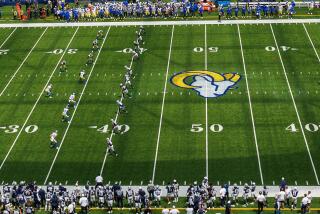This football will tell you if it’s a touchdown
Scientists in Pittsburgh can make footballs talk.
Priya Narasimhan, an associate professor at Carnegie Mellon University, and her team of 10 engineering students have developed a “smart football” with a miniature GPS unit and accelerometer, both contained in a half-ounce microchip inside the ball.
The chip can measure factors such as ball speed, spin, trajectory and — even when it’s buried under a pile of players — the precise location of the football.
The NFL is looking into the technology as a way to make officiating and game timing even more accurate.
Narasimhan and her team are not the only ones to have developed such a chip. According to a Reuters report, German manufacturer Cairos Technologies has been in talks with the NFL about putting its chips in footballs to determine, say, when the ball has crossed the goal line.
Cairos has done the same with soccer balls, creating a system of thin cables under the playing surface that generate magnetic fields that are picked up by sensors in the ball. That location information is transmitted to a central computer, which uses the data to determine when the ball has crossed the goal line. When a goal has been scored, the computer alerts the referee by transmitting a radio signal to his watch.
There are unique challenges to embedding a similar chip in an oblong football, Narasimhan said.
“You can’t change the weight, the spiral, the torque or the feel of the football,” she said. “It is really critically important, otherwise you’ve just ruined the whole purpose. And for that, it became really critical that we look at it from the mechanical engineering viewpoint.”
Some of the challenges aren’t immediately obvious to everyone. For instance, how do you charge a chip that’s depleted of power very quickly? The students in Pittsburgh have developed an inductive-charging system similar to the one used for electric toothbrushes.
Then, there’s fine-tuning the GPS to mark the precise spot, rather than within a few feet or yards. And the signal needs to be strong enough to pass through multiple bodies that might be covering the ball.
It also has to be done economically. The Pittsburgh engineering students say they could produce their chip for about $10.
Simply identifying whether a ball has broken the plane of the goal line isn’t necessarily enough. If the player’s knee touched the ground before the ball crossed the line, for instance, then it wasn’t a touchdown. Narasimhan raises the possibility of putting chips in kneepads, elbow pads and gloves. In other words, it’s all a work in progress.
But, she added, “Having something objectively tell you, ‘This is what’s happening to me,’ is a thing of beauty.”
sam.farmer@latimes.com
More to Read
Go beyond the scoreboard
Get the latest on L.A.'s teams in the daily Sports Report newsletter.
You may occasionally receive promotional content from the Los Angeles Times.











